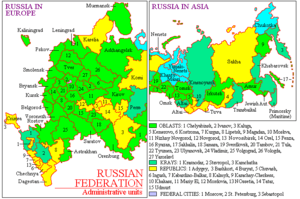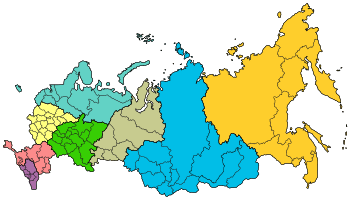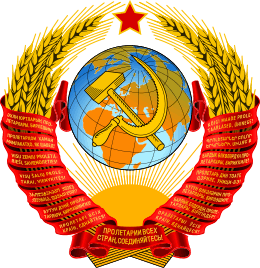European Russia
European Russia is the western and the historical part of the Russian Federation, which is located in Eastern Europe. It spans 39% of Europe's total land area,[1] and comprises 15% of Europe's total population. Although European Russia covers roughly 25% of Russia's total land area, it houses 78% of Russia's total population, with a land area of 3,972,400 square kilometres (1,533,800 sq mi), making Russia the largest country in Europe, and a population of over 110 million residents, making Russia the most populous European nation.
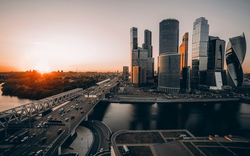
All three federal cities of Russia lie within European Russia, namely Moscow, the capital and the most populous city of the Russian Federation, which is the most populous city entirely within Europe; Saint Petersburg, the cultural capital and the second-most populous city in the country; and Sevastopol, located within the disputed territory of Crimea.
Demographics
Russia is not proportionately populated between its larger Asian portion and its smaller European portion. The European portion contains about 110 million people out of Russia's total population of about 144 million (making it the most populous European country) in an area covering nearly 4,000,000 km2 (1,500,000 sq mi); (making it by far the largest European country) an average of 27.5 people per kilometre2 (70 per sq mi).[2]:6[2]:10 The Asian portion of Russia, mostly encompassing Siberia, makes up more than 75% of the country's territory with 22% of its population at 2.5 people per kilometre2 (6.5 per sq mi).[2]:6
History
The historical population of European Russia was composed of Slavic, Finno-Ugric, German, Turkic, Caucasian, Scandinavian, Baltic, Finnic, Khazarian, Hungarian and Norse peoples.[3][4][5][6]
Some theories say that some early Eastern Slavs arrived in modern-day western Russia (also in Ukraine and Belarus) sometime during the middle of the first millennium AD.[7] The Eastern Slavic tribe of the Vyatichis was native to the land around the Oka river. Finno-Ugric, Baltic and Turkic tribes were also present in the area (although large parts of the Turkic and Finno-Ugric people were absorbed by the Slavs, there are great minorities in European Russia today). The western region of Central Russia was inhabited by the Eastern Slavic tribe of the Severians.
One of the first Rus' regions according to the Sofia First Chronicle was Veliky Novgorod in 859. In late 8th and early-to-mid-9th centuries AD the Rus' Khaganate was formed in modern western Russia. The region was a place of operations for Varangians, eastern Scandinavian adventurers, merchants, and pirates. From the late 9th to the mid-13th century a large section of today's European Russia was part of Kievan Rus'. The lands of Rus' Khaganate and Kievan Rus' were important trade routes and connected Scandinavia, Byzantine Empire, Rus' people and Volga Bulgaria with Khazaria and Persia. According to old Scandinavian sources among the 12 biggest cities of Kievan Rus' or Ancient Rus' were Novgorod, Kiev, Polotsk, Smolensk, Murom and Rostov.[8]
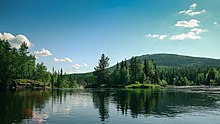
Through trade and cultural contact with Byzantine Empire, the Slavic culture of the Rus' adopted gradually the Eastern Orthodox religion. Many sources say that Ryazan, Kolomna, Moscow, Vladimir and Kiev were destroyed by the Mongol Empire. After the Mongol invasion the Muscovite Rus' arose, over all this time, western Russia and the various Rus' regions had strong cultural contacts with the Byzantine Empire, while the Slavic culture was cultivated all the time.[9] The elements of East Slavic paganism and Christianity overlapped each other and sometimes produced even double faith in Muscovite Rus'.[10]
In the fourteenth century Muscovite Russia served as the intermediary in the trade between Europe and Persia as well as Turkey.[11] During all this time, Russian culture had not only strong cultural links and exchanges with Central Europe and Asia, but also with its many ethnic minorities which exist until today in Russia, like Tatars, Ukrainians, Finno-Ugrics, Bashkirs and Chuvashs.[12] While Russia evolved over periods of time with a balanced European influence, it was tsar Peter the Great who wanted to reform Russia and bring it up to a true Western standards and way of life. Peter the Great was able to change Russian society partly, resistance existed among peasants, the traditionalists and Old Believers within the Orthodox Church. With the Soviet Union, Russia was cut off from Western culture. In the nineties, the Russian political elites hoped to integrate Russia into the West.[13][14] The Russian culture was shaped for centuries by the Orthodox faith, Slavic traditions, the Cyrillic script, the geographical location between Europe and Asia, with significant Swedish, Dutch, French, Polish, Lithuanian and German influences, from 1500-1945. Significant cultural influence came also from Tatars, Caucasians, Iran, Mongolia, Ottoman Empire and other Central- and Western Asian cultures.[15][16][17][18][19] Despite all these influences from the Western and Asian-Oriental cultures and many common traditions with Russia, Russian culture was repeatedly exposed to longer isolations which created a independent, different kind of culture, which differed in many elements from both Western cultures and Eastern cultures and created its own Russian otherness.[20][21] In the age of globalization, the Russian elite seeks a development in which Russia, as a sovereign state with its own culture, traditions and identity, can participate in global cooperation.[22][23]

Alignment with administrative divisions
The administrative districts (on a large scale called federal districts) of the Russian Federation do not exactly line up with European Russia, but they are decent approximations, depending on exactly how Europe is defined. There are two major trends, one to use administrative divisions north of the mouth of the Ural River and one to draw a line of falseness from the Ural River, through the town of Yekaterinburg.
The following administrative districts are overwhelmingly European:
| Name of district | Area (km²) |
2017 population |
Population density | Continent notes | |
|---|---|---|---|---|---|
| Central Federal District | 650,200 | 39,209,582[24] | 59.658 | Europe | |
| North Caucasian Federal District | 170,400 | 9,775,770[24] | 56.58 | Europe | |
| Northwestern Federal District | 1,687,000 | 13,899,310[24] | 8.25 | Europe | |
| Southern Federal District[note 1] | 447,900 | 16,428,458[24] | 33.46 | Europe | |
| Volga Federal District | 1,037,000 | 29,636,574[24] | 28.63 | Predominantly Europe | |
| Ural Federal District | 1,818,500 | 12,345,803[24] | 6.86 | Predominantly Asia | |
| Sum of 6 Federal Districts[note 2] | 3,992,500 | 108,949,694[24] | 27.22 | Predominantly Europe | |
| |||||
See also
References
- "The Largest Countries In Europe". World Atlas. 23 January 2019.
- Vishnevsky, Anatoly (15 August 2000). "Replacement Migration: Is it a solution for Russia?" (PDF). EXPERT GROUP MEETING ON POLICY RESPONSES TO POPULATION AGEING AND POPULATION DECLINE /UN/POP/PRA/2000/14. United Nations Population Division, Department of Economic and Social Affairs. pp. 6, 10. Archived from the original (PDF) on December 25, 2003. Retrieved 2008-01-14.
- "Khazar | people". Encyclopedia Britannica. Retrieved 2018-12-19.
- Reuter, Timothy (2015). The New Cambridge medieval history. Fouracre, Paul; McKitterick, Rosamond; Reuter, Timothy; Luscombe, D. E. (David Edward); Riley-Smith, Jonathan, 1938-2016; Abulafia, David (First paperback ed.). Cambridge: Cambridge University Press. pp. 497–500. ISBN 9781107449060. OCLC 945367493.
- "Oka River", Wikipedia, 2019-03-03, retrieved 2019-03-03
- James., Minahan (2004). The former Soviet Union's diverse peoples: a reference sourcebook. Santa Barbara, Calif.: ABC-CLIO. pp. 15–16. ISBN 9781576078242. OCLC 659831641.
- "Early East Slavic Tribes in Russia". Study.com. Retrieved 2018-12-19.
- "Ancient Rus: trade and crafts: History of Russian trade and crafts: Business & Law: Russia-InfoCentre". www.russia-ic.com. Retrieved 2019-03-20.
- Orthodox Russia: belief and practice under the tsars. Kivelson, Valerie A. (Valerie Ann), Greene, Robert H., 1975-. University Park, Pa.: Pennsylvania State University Press. 2003. ISBN 027102349X. OCLC 50960735.CS1 maint: others (link)
- Orthodox Russia: belief and practice under the tsars. Kivelson, Valerie A. (Valerie Ann), Greene, Robert H., 1975-. University Park, Pa.: Pennsylvania State University Press. 2003. p. 146. ISBN 027102349X. OCLC 50960735.CS1 maint: others (link)
- Kirsanova, Raisa. "Russia: History of Dress". LoveToKnow. Retrieved 2019-03-03.
- "Who are the Mordvin People?". WorldAtlas. Retrieved 2019-03-20.
- "Europe as a Common Home" (PDF).
- English, Robert David; Svyatets, Ekaterina (Kate) (2014-03-04). "Soviet elites and European integration: from Stalin to Gorbachev". European Review of History: Revue européenne d'histoire. 21 (2): 219–233. doi:10.1080/13507486.2014.888710. ISSN 1350-7486.
- "Iranian Culture and Tradition". Globalization Partners International. 2015-12-03. Retrieved 2019-07-25.
- Trofimov, Yaroslav. "Russia's Turn to Its Asian Past". WSJ. Retrieved 2019-07-25.
- "The Role of the Caucasus in Russian Cultural and Intellectual History". GeoCurrents. Retrieved 2019-07-25.
- "SELJUK & OTTOMAN PERIOD IN ASIA MINOR". www.peraair.com. Retrieved 2019-07-25.
- Cross, S. H. (1946). "The Scandinavian Infiltration into Early Russia". Speculum. 21 (4): 505–514. doi:10.2307/2856771. ISSN 0038-7134. JSTOR 2856771.
- Togo, Kazuhiko (2006), "Russian Strategic Thinking toward Asia, 1996–99", Russian Strategic Thought Toward Asia, Palgrave Macmillan US, pp. 75–109, doi:10.1057/9780230601734_4, ISBN 9781349536191
- "How Russia Met the World". The Globalist. 2004-08-03. Retrieved 2019-07-25.
- "İstanbul Haberleri - CRSEA: Russia and Turkey are building the cultural bridge between Europe and Asia - Merkez Haberleri". www.hurriyet.com.tr. Retrieved 2019-08-04.
- Gould-Davies (Winter 2016). "Russia's Sovereign Globalization: Rise, Fall and Future". Chatham House.
- "Population 1 January 2015 Estimate – Federal State Statistics Service Russia". Federal State Statistics Service Russia.
